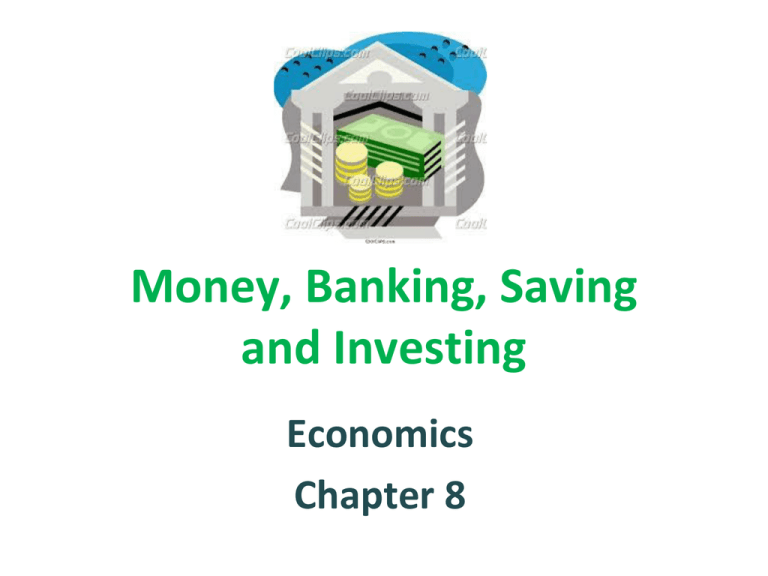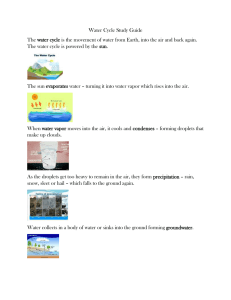Money, Banking, Saving and Investing Economics Chapter 8
advertisement

Money, Banking, Saving and Investing Economics Chapter 8 Money and Banking Objective: • SWBT identify the roles of money, banking, and financial institutions in the U.S. economy Agenda: • CBM #4 (Ch 7-8) • Oral Presentations Market Structures • Chapter 8 ppt + Notes • Exit Activity – Origins of Money Grandma • Imagine your Grandma gives you $5,000! • What would you choose to do with your money? Why? • What other options would you consider? • In the long term, do you think this would be the wisest choice? – Bank – Asset – Credit card – Debit card – Saving – Interest – Principal – Investing – Diversification How do these words help you answer the question: “How should you spend, save and invest your money?” Red Paper Clip • http://www.youtube.com/watch?v=BE8b02 EdZvw • Did Kyle MacDonald use “money” to get his house? What Makes Money…Money? • Money – anything that is generally accepted as a means of payment • 3 Functions of Money: – Medium of Exchange – legal tender – Standard of Value (one scale – US$) – Store of Value – holds its value over time -- purchasing power (quantity of goods and services that can be bought with a particular sum of money) Money Has 6 Main Characteristics 1. Acceptability • Throughout the ancient Mediterranean, traders accepted salt as a medium of exchange • Roman soldiers received salt as their salarium -- salary Money Has 6 Main Characteristics 2. Scarcity • In the ancient world, salt was scarce in most places – yet demand was great – Preserved food – Used in religious ceremonies • Scarcity made it valuable – Traded equally with gold in Africa Money Has 6 Main Characteristics 3. Portability • Salt is portable to some extent • Imagine lugging several large bags of salt to the mall • How messy is it to buy a pair of jeans for three cups of salt? Money Has 6 Main Characteristics 4. Durability • In the ancient world (and today) salt can last a long time – but only if kept dry • How would you feel if a rainstorm washed away your fortune? Money Has 6 Main Characteristics 5. Divisibility • A bag of salt can be easily split into smaller parts • This divisibility made it useful medium of exchange Money Has 6 Main Characteristics 6. Uniformity • Like dollar bills, in the ancient world, all salt was pretty much the same A Brief History of Money • Commodity Money – gold, silver, salt, tobacco, cattle – goods that had value in trade • Bank: a business that receives deposits and makes loans Loan: transaction in which a lender gives money to a borrower who agrees to pay it back A Brief History of Money • Commodity Backed Money – banknotes given in exchange for gold and silver – Banknotes – forerunners of printed money issued by governments • Paper Money today is no longer backed by gold or silver – now its called fiat money (based on govt regulation or law) • US Dollars are backed by the full faith and credit of the US Government What Counts as Money Today? • Currency – bills and coins circulating throughout the economy • What else counts as money? -- Assets – Liquid assets – anything that can be easily converted to cash – Checkable deposits – deposits in checking accounts – Travelers Checks – not used much anymore What Else Counts As Money? • Are savings accounts considered money? – No, it is “near money” not used to directly buy things • Are Credit Cards Money? – No, credit is an arrangement that allows you to buy now with borrowed “money” but pay later • Are Debit Cards Money? – No, they are similar to checks, they instruct a bank who to pay Exit Ticket • Using your class notes, complete the handout on The Origins of Money • List and define the 3 functions of money • Then consider former mediums of exchange and analyze each in terms of how well it functions as money Exit Ticket: Complete the Diagram and hand it in Money Today Functions of Money What Makes Money … Money? Historical Types of Money Characteristics of Money



